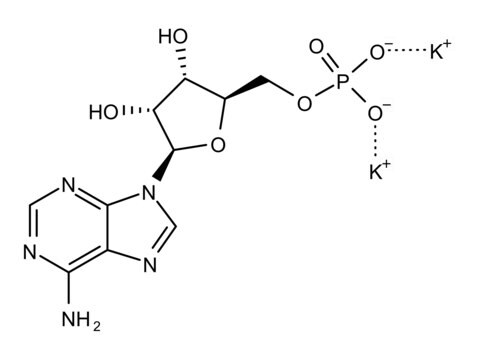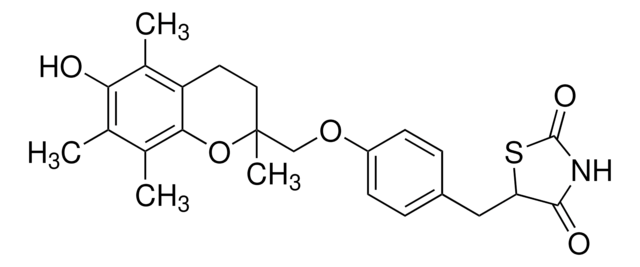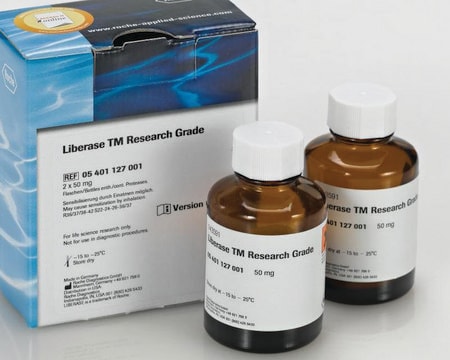SRP0195
PARP6 Active human
recombinant, expressed in baculovirus infected insect cells, ≥70% (SDS-PAGE)
Synonym(s):
MGC131971, Poly (ADP-ribose) Polymerase 6, pART17
Sign Into View Organizational & Contract Pricing
All Photos(1)
About This Item
UNSPSC Code:
12352200
NACRES:
NA.32
Recommended Products
biological source
human
recombinant
expressed in baculovirus infected insect cells
Assay
≥70% (SDS-PAGE)
form
aqueous solution
mol wt
98 kDa
packaging
pkg of 10 μg
concentration
>0.02 mg/mL
NCBI accession no.
UniProt accession no.
shipped in
dry ice
storage temp.
−70°C
Gene Information
human ... PARP6(56965)
General description
PARP6 (poly(ADP-ribose) polymerase family member 6) gene is localized to human chromosome 15q23. It is a member of the family of multifunctional nuclear proteases known as PARPs, which contains 17 members and is further classified into three subtypes dependent on the catalytic domain structure. PARP6 is a type of mono(ADP-ribosyl) transferase on the basis that its catalytic domain has a significantly shorter nicotinamide-ribose-binding site than PARP1. This subfamily contains nine members including PARP6. PARP6 is composed of 630 residues and has a molecular weight of 71kDa.
Human PARP6 (GenBank Accession No. NM_020214), full length with N-terminal GST tag, MW = 98kDa, expressed in a Baculovirus infected Sf9 cell expression system.
Human PARP6 (GenBank Accession No. NM_020214), full length with N-terminal GST tag, MW = 98kDa, expressed in a Baculovirus infected Sf9 cell expression system.
Application
Useful for the study of enzyme kinetics, screening inhibitors, and selectivity profiling.
Biochem/physiol Actions
PARP6 (poly(ADP-ribose) polymerase family member 6) negatively controls cell cycle, as its ectopic expression in HeLa cells leads to suppression of cell growth. It functions as a tumor suppressor in CRC (colorectal cancer), and its expression is associated with good prognosis. The ectopic expression of PARP6 results in suppressed expression of the oncogene survivin. In CRC PAPR6 prevents colony formation, invasion, migration, and cell proliferation.
Unit Definition
One unit of PARP incorporates 100 pmoles of poly(ADP) in 1 minute (room temperature) from NAD into acid-insoluble form.
Physical form
Formulated in 25 mM Tris-HCl, pH 8.0, 100 mM NaCl, 0.05% Tween-20, 50% glycerol and 3 mM DTT.
Preparation Note
Thaw on ice. Upon first thaw, briefly spin tube containing enzyme to recover full content of the tube. Aliquot enzyme into single use aliquots. Store remaining undiluted enzyme in aliquots at -70°C. Note: Enzyme is very sensitive to freeze/thaw cycles.
Certificates of Analysis (COA)
Search for Certificates of Analysis (COA) by entering the products Lot/Batch Number. Lot and Batch Numbers can be found on a product’s label following the words ‘Lot’ or ‘Batch’.
Already Own This Product?
Find documentation for the products that you have recently purchased in the Document Library.
Guangying Qi et al.
Oncotarget, 7(14), 18812-18824 (2016-03-05)
Poly (ADP-ribose) polymerases (PARPs) are enzymes that transfer ADP-ribose groups to target proteins and are involved in a variety of biological processes. PARP6 is a novel member, and our previous findings suggest that PARP6 may act as a tumor suppressor
Handan Tuncel et al.
International journal of oncology, 41(6), 2079-2086 (2012-10-09)
Poly(ADP-ribose) polymerase (PARP) is an enzyme that mediates post-translational modification of proteins. Seventeen known members of the PARP superfamily can
Our team of scientists has experience in all areas of research including Life Science, Material Science, Chemical Synthesis, Chromatography, Analytical and many others.
Contact Technical Service




